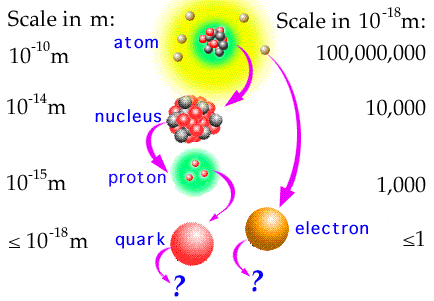Leptons (the most famous being the electron), and quarks (of which baryons, such as protons and neutrons, are made) combine to form atoms, which in turn form molecules. Because atoms and molecules are said to be matter, it is natural to phrase the definition as: ordinary matter is anything that is made of the same things that atoms and molecules are made of. (However, notice that one also can make from these building blocks matter that is not atoms or molecules.) Then, because electrons are leptons, and protons and neutrons are made of quarks, this definition in turn leads to the definition of matter as being "quarks and leptons", which are the two types of elementary fermions. Carithers and Grannis state: Ordinary matter is composed entirely of first-generation particles, namely the [up] and [down] quarks, plus the electron and its neutrino. (Higher generations particles quickly decay into first-generation particles, and thus are not commonly encountered.)
This definition of ordinary matter is more subtle than it first appears. All the particles that make up ordinary matter (leptons and quarks) are elementary fermions, while all the force carriers are elementary bosons. The W and Z bosons that mediate the weak force are not made of quarks or leptons, and so are not ordinary matter, even if they have mass. In other words, mass is not something that is exclusive to ordinary matter.
The quark–lepton definition of ordinary matter, however, identifies not only the elementary building blocks of matter, but also includes composites made from the constituents (atoms and molecules, for example). Such composites contain an interaction energy that holds the constituents together, and may constitute the bulk of the mass of the composite. As an example, to a great extent, the mass of an atom is simply the sum of the masses of its constituent protons, neutrons and electrons. However, digging deeper, the protons and neutrons are made up of quarks bound together by gluon fields (see dynamics of quantum chromodynamics) and these Gluons fields contribute significantly to the mass of hadrons. In other words most of what composes the "mass" of ordinary matter is due to the binding energy of quarks within protons and neutrons. For example, the sum of the mass of the three quarks in a nucleon is approximately 12.5 MeV/c2, which is low compared to the mass of a nucleon (approximately 938 MeV/c2).The bottom line is that most of the mass of everyday objects comes from the interaction energy of its elementary components.








No comments:
Post a Comment